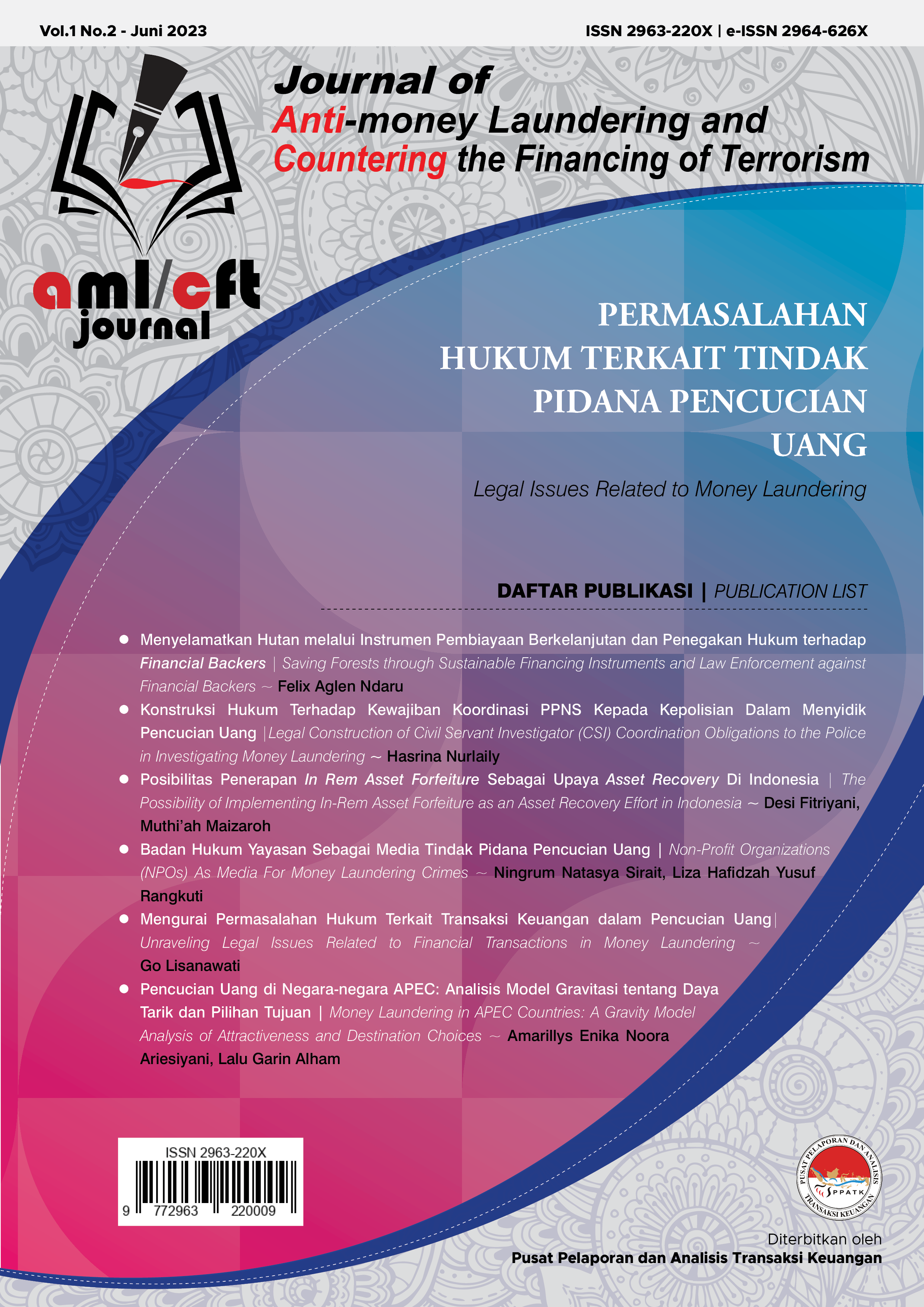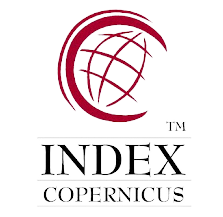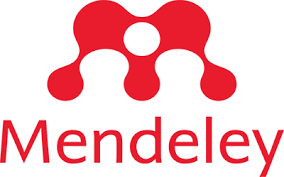Money Laundering in APEC Countries
A Gravity Model Analysis of Attractiveness and Destination Choices
DOI:
https://doi.org/10.59593/amlcft.2023.v1i2.56Keywords:
Money Laundering, Gravity Model, Money Laundering Attractiveness, APEC, Economics, Financial Crime, GovernanceAbstract
This paper has three main contributions. First it attempts to measure which APEC countries are attractive destinations for money laundering to Indonesia. Second it measures and ranks the degree of money laundering attractiveness in-between APEC country members themselves. Third, it tests the variables contributing to a country’s money laundering attractiveness. The attractiveness is measured using the Gravity model derived from Newtonian gravitational equations by utilizing variables ranging from countries’ wealth, government attitude on money laundering, corruption perception index, SWIFT membership, conflict, financial secrecy, and physical & cultural distances. Pearson correlation analysis is also employed to test the statistical interaction & correlation between corresponding variables. Our simulations show that several countries consistently sit on the top 3 (three) most attractive money laundering destinations: Singapore, Hongkong, and the United States. It is also found that financial secrecy and GNI per capita significantly correlate with the degree of money laundering attractiveness. This analysis unveils that an attractive financial regime (beneficial ownership and bank secrecy) and a strong economy attract money launderers to conceal their ill-gotten money in a country.
Downloads
References
Adefeso, H. A. (2018, March). Corruption, Political Instability and Development Nexus in Africa: A call for Sequential Policies Reforms. MPRA Paper. Retrieved April, 2023, from https://mpra.ub.uni-muenchen.de/85277/
Alfada, A. (2019). The destructive effect of corruption on economic growth in Indonesia: A threshold model. Heliyon, 5(10). https://doi.org/10.1016/j.heliyon.2019.e02649
Balani, H., Lewer, J. J., & Saenz, M. (2017). Trade Based Money Laundering in Select Asian Economies: A Comparative Approach Using the Gravity Model. Southwestern Economic Review, 44(1), 15-28. Retrieved March, 2023, from https://digitalcommons.georgiasouthern.edu/economics-facpubs/187
Bates, J. K. (2014). A Gravitational Model of Crime Flows in Normal, Illinois: 2004-2012. The Park Place Economist, 22. Retrieved March, 2023, from https://digitalcommons.iwu.edu/parkplace/vol22/iss1/10
Benedictis, L. D., & Taglioni, D. (2011). The Gravity Model in International Trade. In The Trade Impact of European Union Preferencial Policies. Springer. Retrieved March, 2023, from https://ssrn.com/abstract=2384045
Caselaw Access Project. (1982, November 10). United States v. Four Million Two Hundred & Fifty-Five Thousand, Six Hundred & Twenty-Five Dollars & Thirty-Nine Cents, 551 F. Supp. 314 (1982). Caselaw Access Project Harvard Law School. Retrieved April 2, 2023, from https://cite.case.law/f-supp/551/314/
Chartrand, G. (1985). Introductory graph theory. Dover. https://archive.org/details/introductorygrap0000char
Encyclopaedia Britannica. (n.d.). Development of Gravitational Theory. Encyclopedia Britannica. Retrieved April 9, 2023, from https://www.britannica.com/summary/gravity-physics
FATF. (1990). FATF on Money Laundering Report. FATF. Retrieved April, 2023, from https://www.fatf-gafi.org/content/dam/fatf/documents/reports/1990%20ENG.pdf
Ferwerda, J., Kattenberg, M., Chang, H.-H., Unger, B., Groot, L., & Bikker, J. A. (2013). Gravity Models of Trade-Based Money Laundering. Applied Economics, 45(22), 3170-3182. https://www.tandfonline.com/doi/abs/10.1080/00036846.2012.699190
Ferwerda, J., van Saase, A., Unger, B., & Getzner, M. (2020, 29 October). Estimating Money Laundering Flows with a Gravity Model-Based Simulation. Scientific Reports, (10). https:/doi.org/10.1038/s41598-020-75653-x
Financial Crimes Enforcement Network. (n.d.). History of Anti-Money Laundering Laws. FinCEN. Retrieved April 2, 2023, from https://www.fincen.gov/history-anti-money-laundering-laws
Financial Secrecy Index. (2022). Financial Secrecy Index 2022. Financial Secrecy Index – Tax Justice Network. Retrieved April 10, 2023, from https://fsi.taxjustice.net/
History of the FATF. (n.d.). FATF. Retrieved April 2, 2023, from https://www.fatf-gafi.org/en/the-fatf/history-of-the-fatf.html
Kamin, K. (2022, June). Bilateral trade and conflict heterogeneity: The impact of conflict on trade revisited. Kiel Working Paper, (2222). Retrieved March, 2023, from https://www.econstor.eu/bitstream/10419/261298/1/1808797264.pdf
Kumar, V. A. (2012). Money Laundering: Concept, Significance and its Impact. European Journal of Business and Management, 4(2), 113-119. Retrieved April, 2023, from https://core.ac.uk/download/pdf/234624157.pdf
Linde, D. v. d., & Unger, B. (Eds.). (2013). Research Handbook on Money Laundering. Edward Elgar.
Pearson, K. (1895). Notes on Regression and Inheritance in the Case of Two Parents. Proceedings of the Royal Society of London, 58(347-352), 240-242. https://doi.org/10.1098/rspl.1895.0041
Polachek, S. W. (1980, March). Conflict and Trade. The Journal of Conflict Resolution, 24(1), 55-78. Retrieved March, 2023, from https://www.jstor.org/stable/173934
Ryder, N. (2008, November). The Financial Services Authority and Money Laundering a Game of Cat and Mouse. The Cambridge Law Journal, 67(3), 635-653. Retrieved April, 2024, from https://www.jstor.org/stable/25166446
Smith, T. S. (1976, June). Inverse Distance Variations for the Flow of Crime in Urban Areas. Social Forces, 54(4), 802-815. https://doi.org/10.2307/2576176
The World Bank. (2017). GNI per capita, Atlas method (current US$) | Data. World Bank Data. Retrieved April 9, 2023, from https://data.worldbank.org/indicator/NY.GNP.PCAP.CD
The World Bank Group. (n.d.). Why use GNI per capita to classify economies into income groupings? – World Bank Data Help Desk. World Bank Data Help Desk. Retrieved April 9, 2023, from https://datahelpdesk.worldbank.org/knowledgebase/articles/378831-why-use-gni-per-capita-to-classify-economies-into
UCDP. (2022). Uppsala Conflict Data Program. Uppsala Conflict Data Program: UCDP. Retrieved April 10, 2023, from https://ucdp.uu.se/
UNODC. (n.d.). Money Laundering. UNODC. Retrieved April 7, 2023, from https://www.unodc.org/unodc/en/money-laundering/overview.html
Walker, J. (n.d.). Overview Report: Quantification of Money Laundering. Gov.bc.ca. Retrieved April 7, 2023, from https://ag-pssg-sharedservices-ex.objectstore.gov.bc.ca/ag-pssg-cc-exh-prod-bkt-ex/323%20-%20Quantification%20of%20ML%20OR%20Revised%20FINAL.pdf
Walker, J. (n.d.). Overview Report: Quantification of Money Laundering A. Scope of Overview Report 1. This Overview Report is about estimating the. Gov.bc.ca. Retrieved March 17, 2023, from https://ag-pssg-sharedservices-ex.objectstore.gov.bc.ca/ag-pssg-cc-exh-prod-bkt-ex/323%20-%20Quantification%20of%20ML%20OR%20Revised%20FINAL.pdf
Walker, J. (1999). How Big is Global Money Laundering? Journal of Money Laundering Control, 3, 25-37. Retrieved March, 2023, from https://ag-pssg-sharedservices-ex.objectstore.gov.bc.ca/ag-pssg-cc-exh-prod-bkt-ex/327%20-%20How%20Big%20is%20Global%20Money%20Laundering%20-%20Journal%20of%20Money%20Laundering%20Control-Walker-1999.pdf
Walker, J., & Unger, B. (2009). REVIEW OF LAW AND ECONOMICS. Measuring Global Money Laundering: “The Walker Gravity Model”, 821-853. Retrieved March, 2023, from http://www2.econ.uu.nl/users/unger/publications/RLE2.pdf
Worldwide Governance Indicators. (2022). WGI 2022 Interactive > Home. World Bank. Retrieved April 10, 2023, from https://info.worldbank.org/governance/wgi/
Yu, S. (2019). Still Keeping Secrets? Bank Secrecy, Money Laundering, and Anti-Money Laundering in Switzerland and Singapore. IALS Student Law Review, 6(1), 19-25. Retrieved March, 2023, from https://journals.sas.ac.uk/lawreview/article/view/4955/4895
Downloads
Submitted
Accepted
Published
How to Cite
Issue
Section
License
Copyright (c) 2023 Amarillys Enika Noora Ariesiyani, Lalu Garin Alham

This work is licensed under a Creative Commons Attribution-ShareAlike 4.0 International License.
Authors who publish with this journal agree to the following terms:
Authors retain copyright and grant the journal right of first publication with the work simultaneously licensed under a Creative Commons Attribution-ShareAlike 4.0 International License that allows others to share the work with an acknowledgement of the work's authorship and initial publication in this journal.
Authors are able to enter into separate, additional contractual arrangements for the non-exclusive distribution of the journal's published version of the work (e.g., post it to an institutional repository or publish it in a book), with an acknowledgement of its initial publication in this journal.




















